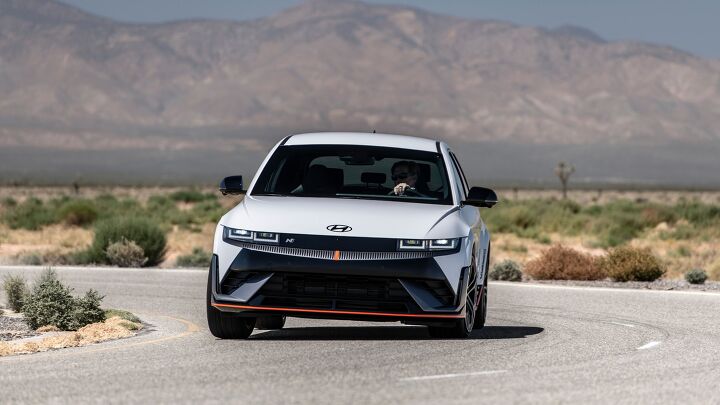The 2025 Hyundai Ioniq N Will Land With an Almost $70,000 Price Tag

Hyundai is expanding its “N” performance line with the new electric Ioniq 5 N, which will land as a 2025 model. The automaker recently priced the hot EV, making it the most expensive vehicle in its lineup in the United States.
The Ioniq 5 N comes with a hefty $67,475 price tag, which includes a $1,375 destination charge. That price makes it more expensive than the Hyundai Nexo fuel cell vehicle by about five grand and a whopping $25,000 pricier than the cheapest “regular” Ioniq 5. It’s also around $5,000 more than the Kia EV6 GT, the closest rival to the Ioniq 5 N.
Of course, that money buys a lot of performance and plenty of features. Hyundai is selling the EV as a single trim, so it gets all the goodies that would otherwise cost extra. In addition to the power output, which at 601 horsepower and up to 641 ponies with temporary boost engaged, is prodigious and a low-three-second 0-60 mph time, it gets a sporty but well-trimmed interior, plenty of tech, and a load of safety kit.
Hyundai also made substantive updates to the Ioniq 5’s propulsion system, including an upgraded thermal management system to prevent battery damage during extreme track driving. Selectable drive modes let the driver dial in performance and energy consumption. The Endurance mode limits peak power output to conserve battery on the track, while Sprint gives full juice for the fastest lap times.
Inside, the hot SUV gets a unique steering wheel design with the N logo and a center console optimized for track driving. It offers a knee pad and shin support, and the armrests are adjustable. Finally, its sport seats come wrapped in synthetic suede and offer heating and ventilation.
[Image: Hyundai]
Become a TTAC insider. Get the latest news, features, TTAC takes, and everything else that gets to the truth about cars first by subscribing to our newsletter.

Chris grew up in, under, and around cars, but took the long way around to becoming an automotive writer. After a career in technology consulting and a trip through business school, Chris began writing about the automotive industry as a way to reconnect with his passion and get behind the wheel of a new car every week. He focuses on taking complex industry stories and making them digestible by any reader. Just don’t expect him to stay away from high-mileage Porsches.
More by Chris Teague
Latest Car Reviews
Read moreLatest Product Reviews
Read moreRecent Comments
- MrIcky My car is header orange which is pretty close to safety cone orange, my truck is (and all my future trucks shall be due to hard lessons learned) white to better hide scratches and branch pinstriping.
- Arthur Dailey Pluses: There were reportedly only 220 of these ever imported into the USA.Minuses: Much of the car was manufactured in South Africa.Then the parts were shipped to England for assembly. As Clarkson, May and Hammond have said, I believe about these cars, 'nothing says quality like being put together by some blokes in a shed in the Midlands'.
- Lou_BC This is ironically funny. When I was in Vancouver I was sitting outside watching vehicles go by on a busy street. I noticed that like this study, most were white, black, or a shade of grey. I decided to roughly count 100 vehicles excluding work vehicles. 80 were greyscale (white - silver - greys - black). 20 were a "colour". When I look back on my vehicles, I've owned 2 blue, 2 red, 1 tu-tone teal/silver, 1 tu-tone silver/dark grey, 1 tu-tone light beige/black, and orange with gold stripping.
- Tassos MOST OF MY CARS CAME WITH DIFFERENT PAINTED PANELS FROM DIFFERENT CARS. MY EUROPEAN E-class was mostly PALE MUSTARD YELLOW BECAUSE IT USED TO BE A GERMAN TAXI (it was the cheapest one I could find and still way beyond my budget). I eventually had it painted so I COULd FIT IN WITH OTHER eastern euro VIPS.
- Astigmatism I agree about boring exterior colors, but what really gets me is that 80%+ of in-stock dealer cars appear to have black (or dark-gray) interiors; for some reason, light gray, tan, and even brown seem to be virtually special-order options. When I got my car last year, one of the reasons I passed on the Volvo plug-in hybrid - a car I actually liked - was because they told me it would be six months before they could get one in without a black interior. WTF?I ordered my car from the factory, so was able to order Portimao Blue with Oyster Dakota leather. I was upset that I couldn't order some of the prettier colors that BMW offers on its other models (the green they have on the M3 is beautiful), and BMW Individual isn't even available for the non-M3 3-series. Oh well, I did the best I could.


































Comments
Join the conversation
Seems silly to quibble about a $67k Hyundai Ioniq in a world of $77k Dodge Durango SRTs that the Hyundai would show its taillights to.
WAIT! We all know Hyundai’s and Kia’s MO. We wait a few months, let the full priced guys buy their cars. We get I5N at steep discounts. The EV6 GT are selling at 45-47k with a few thousand miles on them. New, they are selling 10k off MSRP. No difference for the I5N!